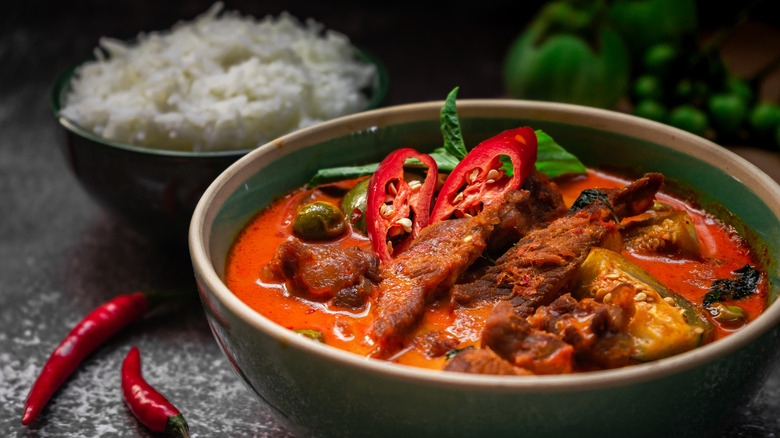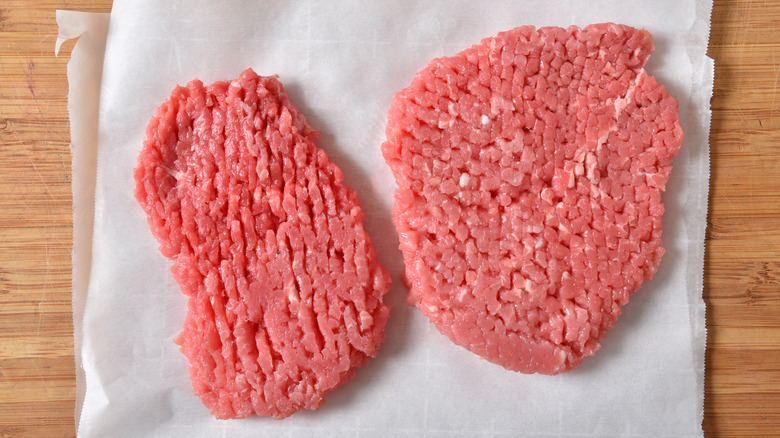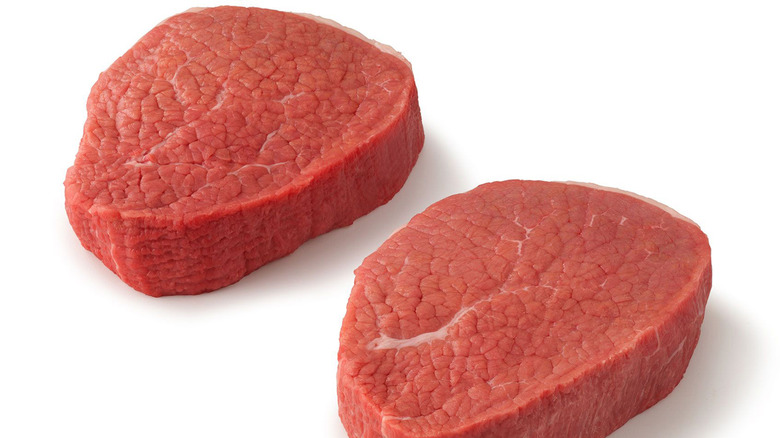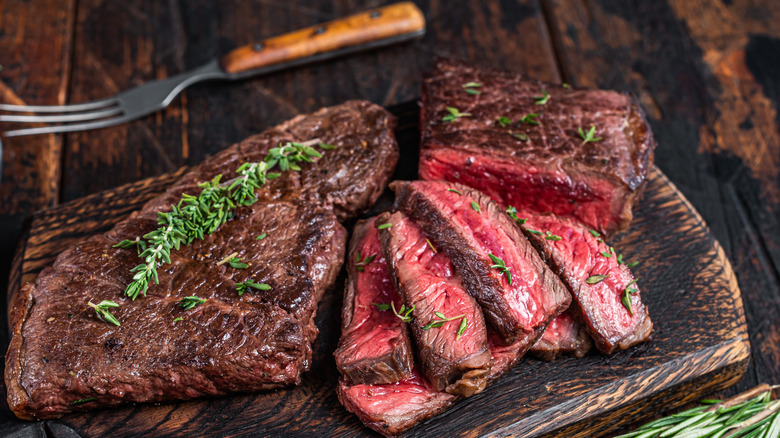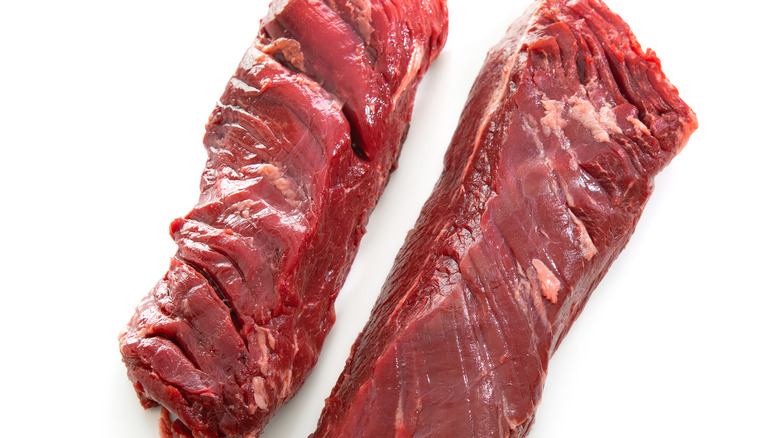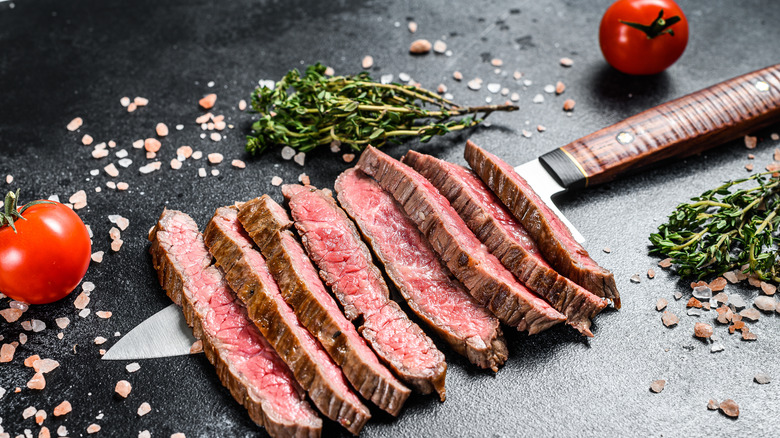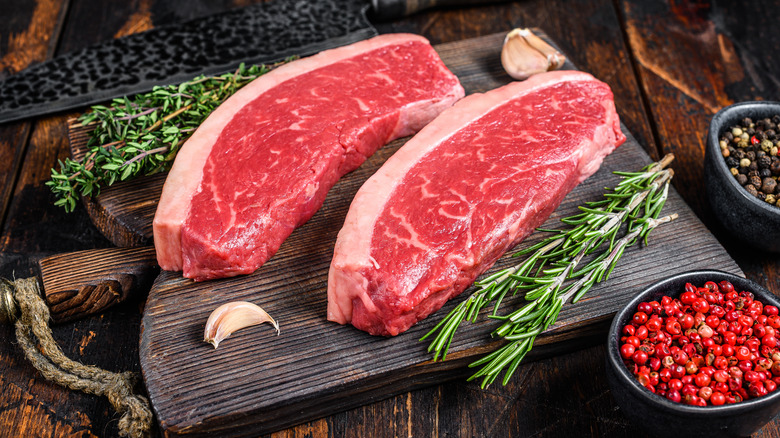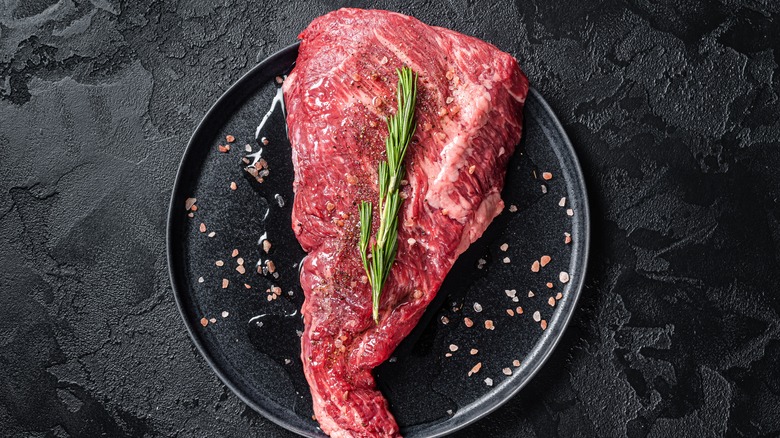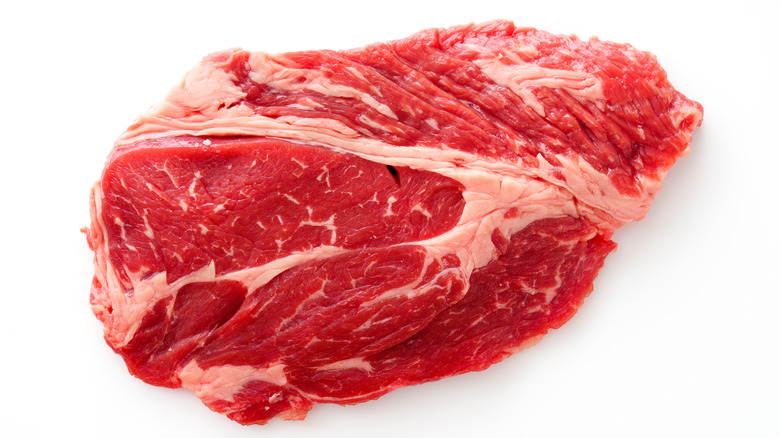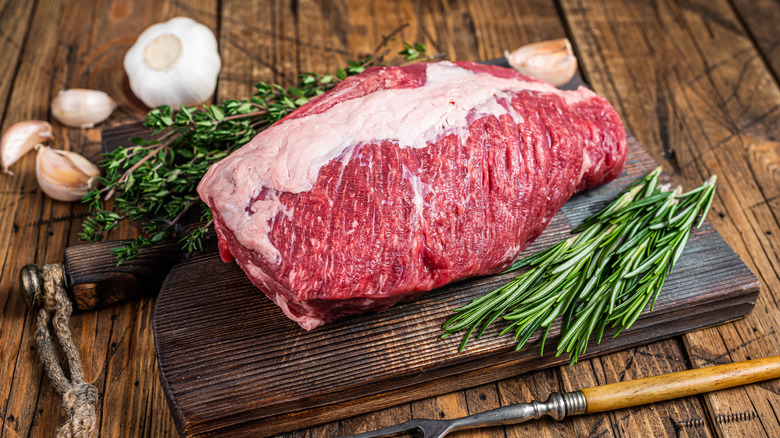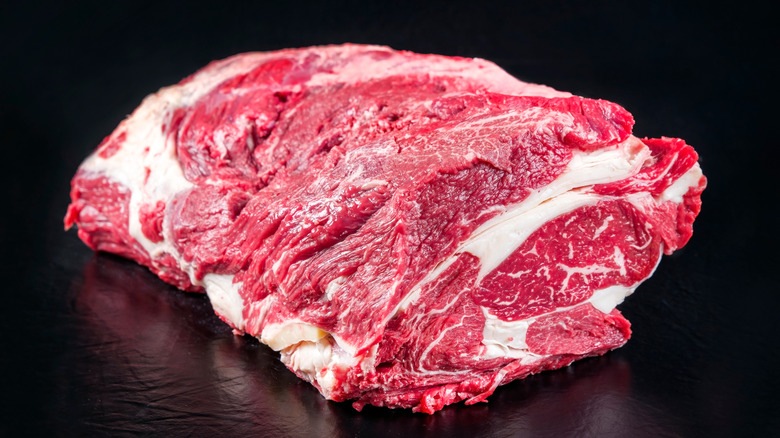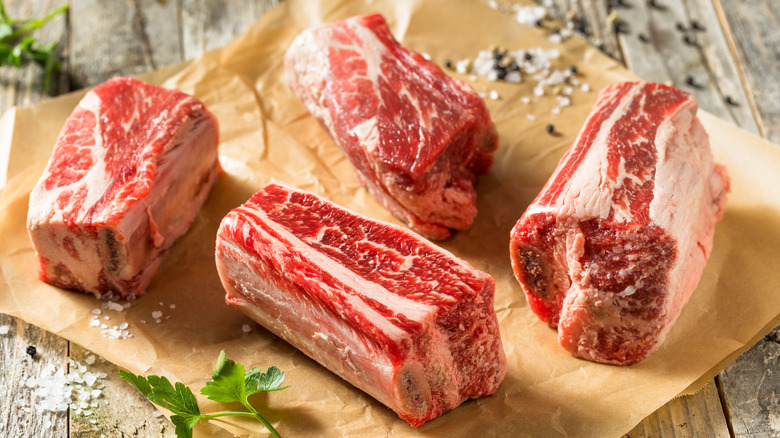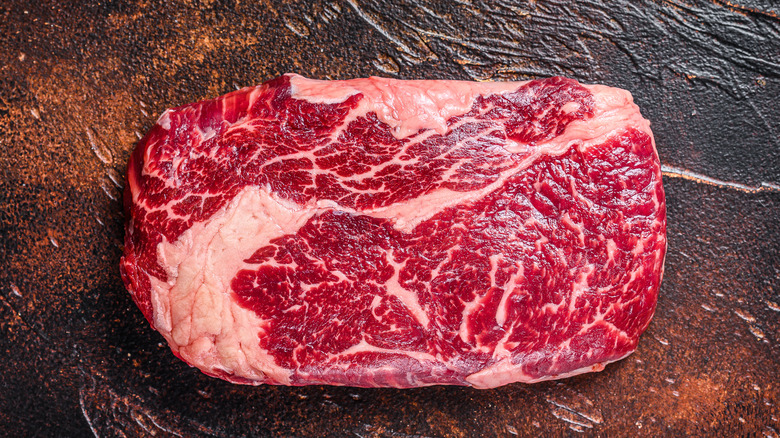Ranking Cuts Of Beef For Chili, From Worst To Best
It doesn't get much better than a delicious, hearty bowl of chili. In fact, according to Insider, chili is one of the most popular meals in America. Of course, like countless other dishes, there are regional varieties that change up the recipe. There's the beanless, meat-heavy "bowl of red" in Texas, the Skyline-style chili of Cincinnati that tends to have a dash of cinnamon or chocolate, and the cajun-inspired chili of Louisiana, just to name a few. While there are plenty of local variations of chili that make each of them different and tasty in their own special ways, most chili dishes often share one main ingredient in common: beef. Yet these beef cuts can vary in taste and tenderness, depending on which part of the cow they come from (via Lone Mountain Wagyu).
The USDA divides cows into eight different main cuts of beef called primal cuts, and those get butchered down into the smaller cuts and portions that we see in packages at grocery stores (via Clover Meadows Beef). All of these different cuts of beef vary in price and texture, depending on how much marbling (the thin strands of intramuscular fat in meat) there is. As marbling increases, so does the flavor and tenderness. But how do you know which cuts are best for chili? Luckily, we're here to help. Here are the various cuts of beef for chili, ranked worst to best.
Cube steak
Even though cube steak's cheaper price tag can make it tempting to buy, if you're looking for higher-quality beef, it's probably best to steer clear. According to Livestrong, cube steak is made from tougher cuts of beef that can be easily overcooked. Because it's made from tough cuts of beef, it often comes pre-tenderized, which is why you see those square-like indentations all over the surface of the meat.
When it comes to chili — or any dish, really — you always want beef to be tender, and tenderness isn't easy to achieve with cube steak. According to the Food Network, cube steak tastes best when it's cooked quickly over high heat due to its low fat content, but that method isn't very conducive to a slow simmering chili. With cube steak in your chili, the odds are pretty high that you'll end up with dreadfully tough chunks of meat that taste more like strips of leather than a succulent piece of beef. The bottom line: If you want to make a great chili that'll knock your socks off, avoid cube steak and opt for a better cut that has more marbling.
Eye of round
Much like cube steak, eye of round is cheap and lean (via No Spoon Necessary). Eye of round's absence of fat and lack of marbling is due to the fact that this cut comes from muscles that get a lot of movement: the legs of the cow. In fact, eye of round is so lean that Lynne Rossetto Kasper, a celebrated food writer and recipient of two James Beard awards, considers the eye of round a lost cause due to its hopelessly tough texture (via The Splendid Table).
Often used for roast beef, eye of round needs to be cooked low and slow to achieve an acceptable level of tenderness. But no amount of low and slow cooking can magically insert the marbling and fat that this cut needs to produce the succulent bites of beef that we truly crave in a good bowl of chili. Once again, a cheaper cut of beef ends up falling short when it comes to taste and texture. Spare your jaw the extra work it'll expend gnawing on this fatless nightmare. To make a great bowl of chili, do yourself a favor and score a better cut of beef.
Skirt steak
Located under the ribs and in between the brisket and flank, skirt steak is a cut of beef commonly used in dishes like fajitas (via Chimichurri Sauce). There is an attached membrane on skirt steak that is often removed but, if left untrimmed, can produce a highly unpleasant chewiness. In general, this chewiness is the main issue with skirt steak. It doesn't help that skirt steak is often cut very thin, which can lead to toughness from overcooking. This is partly because of the strong muscle fibers embedded in this cut of beef (via Kansas City Steaks). The good news is that cutting skirt steak against the grain after it's cooked can create a bite that's much more enjoyable and tender.
Ask yourself: What kind of texture are you going for in your chili? Do you want the beef to be chewy, or do you want it to softly melt in your mouth like butter? Of course, all cuts of beef will have some level of chewiness; that comes with the territory of eating muscle tissue. But ideally, the best beef in chili strikes a perfect balance between these contrasting textures. We're looking for a cut of beef that has enough firmness to hold its shape, yet is tender enough to easily soften under minimal pressure. Skirt steak is a little too chewy for our taste in this context, and there are more flavorsome cuts of beef that would be better suited for a great bowl of chili.
Hanger steak
Now we're moving into better territory. Often confused for skirt steak, hanger steak comes from the same region of the cow, but is a much higher quality (via Carnivore Style). This improvement in quality is mostly due to the fact that the hanger steak is nestled deep inside of the cow, which means that the muscle is hardly used, rewarding this cut of beef with an exceptionally luxurious tenderness. Interestingly, there was a time when the general public had no idea how delicious hanger steaks were, because it was common practice for butchers to save this cut of beef for themselves. This is why hanger steaks are also known as butcher steaks.
The hanger steak's natural tenderness makes it very easy to maintain the beef's delicate structure, making it a solid choice for chili. Bathed in a simmering stew of spices, the hanger steak's inherent succulence beautifully compliments the velvety richness of chili. Bursting with a tender, bold beefiness, hanger steak is a very respectable cut of beef that can work wonders in a batch of chili.
Flat iron
Flat iron steak is named after the hunk of metal that it resembles, and comes from the shoulder of the cow (via Steak Revolution). At first, this cut of beef was considered undesirable due to its highly muscular composition, but as the butchering process improved over time, the connective tissue was removed (via My Chicago Steak). Freed from this connective tissue, cuts of flat iron steak become much more tender.
Because flat iron steaks have a high fat content and a good amount of marbling, these cuts of beef produce a rich and beefy flavor. At the end of the day, that's what we're looking for in a cut of beef: big flavor and tenderness. Flat iron steak is juicy and tender, and it pairs especially well with the luscious liquid of a good chili. This cut of beef produces a balanced, savory mouthfeel that compliments the other ingredients you typically find in chili, like beans, peppers, and sauteed onions.
Top sirloin
Top sirloin is a thick cut of beef that comes from the mid-back area of the cow (via Chef's Resources). This is one of Alton Brown's favorite cuts of beef, and if it's good enough for him, it's certainly good enough for us (via Cooking Channel TV).
Top sirloin is a wonderful candidate for a great chili because it can be easily cooked to whatever temperature you desire without much fear of accidentally overcooking it, since its thickness requires more time to cook and makes it a bit more forgiving compared to thinner, leaner cuts of beef.
Because top sirloin is semi-lean, it offers a great balance in texture. While it may not exactly melt like butter, it still retains a lovely amount of flavor and tenderness, and its resilience can help the meat preserve its structure as it simmers in the chili pot. If you want the beef in your chili to be tender but still have a pleasant bite with a little bounce, then top sirloin is a great choice.
Tri-tip
Named after its triangular shape, the tri-tip is a cut of beef that has a lot to offer (via Chef's Resources). For starters, even though this cut of beef has minimal marbling, it still manages to deliver major flavor, and also tends to be more reasonably priced. Tri-tip's balanced leanness is a great fit for chili, since it won't become overly greasy or lead to excessive pools of fat that can overwhelm the dish.
Chef Virgil Harper, owner of Toast on Lennox, says that tri-tip is one of the most desirable yet underappreciated cuts of beef on the market (via Livestrong). Another advantage of tri-tip is that it's comparable to brisket, but it costs less money and takes less time to cook. Between its deep flavor and inexpensive price tag compared to other steaks, the tri-tip should always be a contender when you're considering cuts of beef for a killer batch of homemade chili.
Be on the lookout for different names at the butcher shop or in the meat section at the grocery store, since tri-tip is often branded under a variety of labels. Some of these names include Santa Maria steak, bottom sirloin butt, Newport steak, bottom sirloin tip, and culotte steak.
Chuck steak (ground beef)
Chuck steak is a cut of beef that comes from the neck and shoulder area of the cow (via Best Beef Recipes). Well-known for being more affordable than more tender cuts of beef from the loin or ribs, chuck steak might be a little on the tough side at first, since it's from an area of the cow that experiences a lot of movement. But don't let that stop you from scoring a hunk of this beef for your chili — with a little prep, you can easily transform this cut of red meat into delicate, juicy pieces of delicious protein.
To get the most out of your chuck steak, hook yourself up with a good meat grinder. There are plenty of great models on the market that won't break the bank — some manual models are only about 30 bucks! By cutting your chuck steak into smaller pieces and then grinding it down, you can create your own fresh mix of ground beef at home. Broken down into bite-sized pieces, ground chuck becomes more palatable and has a ratio of about 20% fat and 80% lean meat (via Smoked BBQ Source). This ratio is often considered as being ideal, since the beef is lean enough to keep its shape yet fatty enough to stay juicy. Plenty of classic chili recipes feature ground beef, so why not make yours from scratch and take your chili to the next level?
Brisket
Brisket is a generous slab of beef that comes from the lower chest of the cow (via Trager). Because brisket is chock full of flavorful connective fat, it's an ideal match for a low and slow cook in a smoker. The smoking process will build flavor around the brisket and gently break down all of its connective tissue in the most delicious way possible, rendering a cut of beef that's wildly flavorful and impressively tender.
Imagine succulent bites of smoked brisket tenderly wading in a steaming bowl of fresh chili. Some bits of the brisket will get a pleasant char from the smoke, adding some extra texture to the chili, and lend the dish an irresistible scent that's bound to leave your mouth watering. Without a doubt, smoked brisket chili is one of our favorite versions of this classic dish, and you can easily whip up a batch yourself with the good cut of beef and a decent smoker. To get an extra flavorful bark, make sure to generously rub your brisket down with seasoning. The rich flavors of smoked brisket are sure to add a deeper taste to the chili.
Chuck roast
Ah, the chuck roast. This thick chunk of beef comes from the area of the cow between the neck and shoulder (via Masterclass). Chuck roasts have a considerably high level of marbling and fat content, which makes them ideal for slow cooking methods. And there's no easier way to turn a fat-riddled chuck roast into a tender pile of shredded beef than a slow cooker.
Shredded chuck roast is definitely one of our favorite forms of beef for a great chili. Sometimes the crumbled graininess of ground beef and the chewier cubes of other cuts leave room for improvement. The texture of shredded, slow-cooked chuck roast, with its delicate strands of juicy beefiness, can take a regular pot of chili and elevate it to sky-high levels of flavor. It also provides a nice contrast to the other textures that are typically found in chili, like chopped onions and beans. While veggies and other ingredients in chili tend to be smaller and more circular in shape, shredded beef has a finer, thread-like quality that's delicate and delicious, and also adds more visual variation to the dish.
Short ribs
Short ribs are usually best braised and go by a few different names on the market (via Chef's Resources). Some of these names include Korean short ribs and crosscut ribs. What makes this cut so suitable for chili is its scrumptious succulence and intensely beefy flavor profile.
If you've never braised short ribs before, there's no need to be intimidated. The process is actually quite simple. After seasoning and searing the ribs, you can braise them in the oven for a few hours with some veggies, herbs, and beef broth. The end result will blow your mind: amazingly tender, juicy, flavorful cuts of beef that deliciously capture the epitome of luxurious nourishment. For even deeper flavors and some subtle sophistication, you can add a few splashes of red wine for red wine braised short ribs. Between other common ingredients like chili peppers, onions, and tomatoes, the sweet, berry-like flavor of wine-braised beef will amplify the tastiness of your chili to impressive new heights. Once you taste your first spoonful from a fresh batch of homemade chili made with short ribs, you'll be hooked for life.
Ribeye
Considered by many to be one of the most prized cuts of beef available, ribeye offers a perfect blend of marbling in a generously-sized filet (via Smoked BBQ Source). Its extraordinary tenderness and deep flavor make the ribeye an ideal cut of beef, and are largely due to its placement in the cow. This cut of beef comes from a muscle that doesn't get too much action during a cow's life, so it stays relatively motionless, which creates an exquisitely high level of delicacy and tenderness.
Adding some flame-grilled ribeye to chili takes the whole dish to a completely new level. Bite-sized chunks of juicy, fire-kissed beef perfectly meld with spices like cumin and chili powder, while the sweet acidity from the tomatoes tenderizes the ribeye even further (via Utah State University). The natural unctuousness of ribeye is vastly enhanced when simmered in a stew of spices, rendering hunks of beef so astonishingly soft that you'll find it hard to go back to using other inferior cuts for your chili.
All things considered, ribeye embodies everything you could possibly want in a great cut of beef, making it by far the absolute best choice when it comes to picking out a superior cut for your chili. Ribeye, we tip our hats to your undeniable deliciousness.
